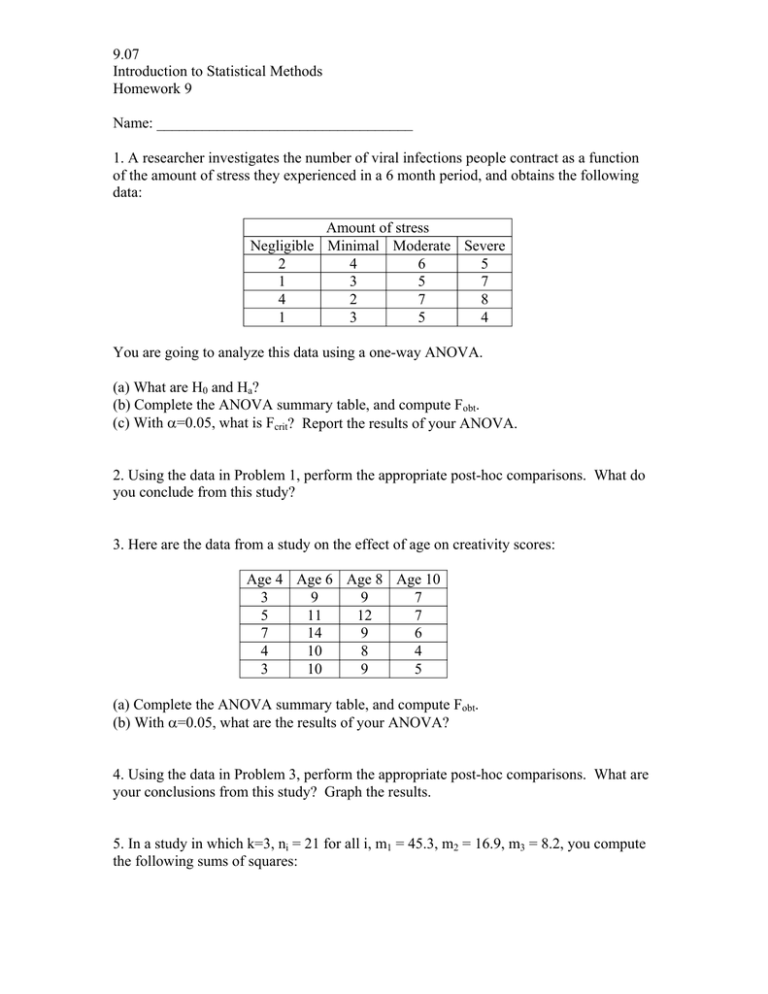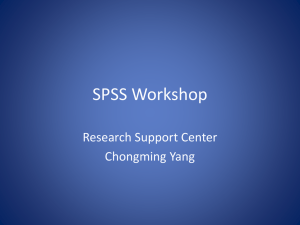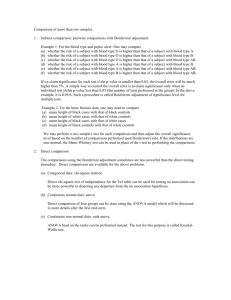9.07 Introduction to Statistical Methods Homework 9 Name: __________________________________
advertisement

9.07 Introduction to Statistical Methods Homework 9 Name: __________________________________ 1. A researcher investigates the number of viral infections people contract as a function of the amount of stress they experienced in a 6 month period, and obtains the following data: Amount of stress Negligible Minimal Moderate Severe 2 4 6 5 1 3 5 7 4 2 7 8 1 3 5 4 You are going to analyze this data using a one-way ANOVA. (a) What are H0 and Ha? (b) Complete the ANOVA summary table, and compute Fobt. (c) With α=0.05, what is Fcrit? Report the results of your ANOVA. 2. Using the data in Problem 1, perform the appropriate post-hoc comparisons. What do you conclude from this study? 3. Here are the data from a study on the effect of age on creativity scores: Age 4 Age 6 Age 8 Age 10 3 9 9 7 5 11 12 7 7 14 9 6 4 10 8 4 3 10 9 5 (a) Complete the ANOVA summary table, and compute Fobt. (b) With α=0.05, what are the results of your ANOVA? 4. Using the data in Problem 3, perform the appropriate post-hoc comparisons. What are your conclusions from this study? Graph the results. 5. In a study in which k=3, ni = 21 for all i, m1 = 45.3, m2 = 16.9, m3 = 8.2, you compute the following sums of squares: 9.07 Introduction to Statistical Methods Homework 9 Name: __________________________________ Source Sum of squares Between 147.32 Within 862.99 Total 1010.31 df MS F ____ __________ ________ ____ __________ ____ (a) Complete the ANOVA summary table. (b) With α=0.05, what do you conclude from the ANOVA? (c) Perform the appropriate post-hoc comparisons. (d) What proportion of the variance is accounted for by the effect of the independent variable? 6. A researcher investigated the effect of the volume of the background noise on participants’ accuracy rates while performing a boring task. He tested 3 groups of randomly selected students, and obtained the following means and sums of squares: Mean ni Low volume Moderate volume High volume 61.5 65.5 48.25 4 5 7 Source Sum of squares Between 652.16 Within 612.75 Total 1264.92 df MS F ____ __________ ________ ____ __________ ____ (a) Complete the ANOVA. (b) At a=0.05, what is Fcrit? Report the results of the ANOVA. (c) Perform the appropriate post-hoc tests. (d) What do you conclude from this study? 7. An experimenter studies whether audio-visual synchrony has an effect on recall of spoken materials. Subjects are shown a film of a person repeating a list of 50 common words. One group of subjects sees a normal film, in which the audio and video are synchronized. A second group, labeled “fast sound,” sees a film in which the voice and lips are out of synchrony, with the sound preceding the video. The third group, labeled “slow sound,” sees a film in which one can hear the sound slightly after seeing the corresponding lip movements. After the film, each subject recalled as many of the 50 words as they could, and the researcher measured the number of recalled words. The data is shown in the following table: 9.07 Introduction to Statistical Methods Homework 9 Name: __________________________________ Fast sound Normal sound Slow sound 23 27 23 22 28 24 18 33 21 15 19 25 29 25 19 30 29 24 23 36 22 16 30 17 19 26 20 17 21 23 Complete the analysis of variance. Show the summary table, and state the results of the ANOVA. 8. A researcher studies the effect of a lesion introduced into a particular structure in a rat’s brain on the rat’s ability to perform a discrimination task. The structure is bilaterally symmetric. Group I had a lesion on the right side, group II on left side, group III on both sides, and group IV had no lesion (a control group). The following is the performance data for the rats in the 4 groups: I 20 18 26 19 26 24 26 Group II III 24 20 22 22 25 30 25 27 20 22 21 24 34 28 18 21 32 23 23 25 22 18 30 32 IV 27 35 18 24 28 32 16 18 25 Complete the analysis of variance. Show the summary table, and state the results of the analysis. 9.07 Introduction to Statistical Methods Homework 9 Name: __________________________________ 9. In a study of the effects of reward on learning, there were 4 groups. Each child was given a puzzle which could be solved only if a sequence of steps were taken in order. In Group I, the child was rewarded for every correct move until the puzzle was solved. In Group II (frequent reward), 75% of a child’s correct moves were rewarded, on a random schedule. In Group III, the child was rewarded infrequently, for 25% of their correct moves. In Group IV, no moves were rewarded. The experimenter wants to test the following hypotheses: (i) Constant reward will produce faster learning than the average of the other conditions (ii) Frequent reward will produce faster learning than the average of infrequent or no reward (iii) Infrequent reward will produce faster learning than no reward (a) Find weights corresponding to each of these three hypotheses, and show that the 3 are independent (b) Test each of the experimenter’s hypotheses, using a per-comparison α=0.017, and planned comparisons (you can use online statistical tables like those at http://math.uc.edu/~brycw/classes/148/tables.htm to get tcrit for α=0.017). The data is shown below: Group Constant reward Frequent Infrequent Never 12 9 15 17 13 10 16 18 11 9 17 12 12 13 16 17 12 14 16 19 (c) If all three of the planned comparisons is tested for significance with α=0.017, what is the experiment-wise probability of a Type I error? If each were tested using α=0.05, what is the experiment-wise probability of a Type I error? 9.07 Introduction to Statistical Methods Homework 9 Name: __________________________________ 10. Consider a set of seven groups, each containing 10 subjects. Planned comparisons are to be made with the following weights: I 4 1 0 Groups II III IV V VI VII 4 4 -3 -3 -3 -3 1 -2 0 0 0 0 0 0 1 1 -1 -1 (a) Show that the comparisons are orthogonal (i.e. independent) (b) Find the weights for three additional comparisons, such that the full set of 6 comparisons is orthogonal. (c) For the new comparisons you have suggested, what is the interpretation of the comparison in terms of comparing the means of the different conditions?



